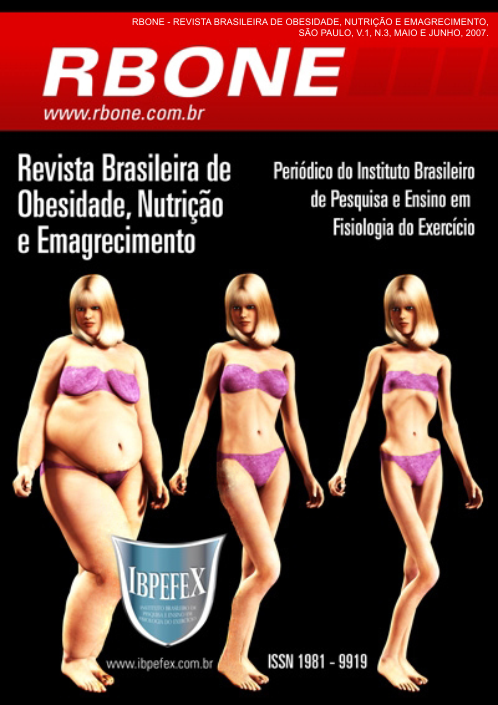Dietetic profile of obese women assisted in a nutrition ambulatory of Rio de Janeiro
Abstract
Considered as a public health problem, the prevention of the obesity is one of the highest challenges of this century. This study had as purpose to evaluate the degree of obesity and the eating habits of outpatient volunteers in the basic health services from e city of Rio de Janeiro. Sixty female volunteers aged 20 to 59 years were studied and it was determined body mass index higher than 30 kg/m2. It was observed a high number of women with I degree obesity, followed of those with degree II and III. An analysis of the eating habits was made using a food frequency questionnaire adapted to become only qualitative, and it was observed a low frequency of intake of some foods such as milk and derivates, cool fish, vegetables A and B and fruits. It was observed and inverse association between obesity and A and B vegetables, which was characterized as a frequency lower than one time per week. A high frequency of sausages and fast foods intake was observed. 79% of women had an adequate intake of bovine meat and chicken. The data also show that Brazilian obese women have losted national typical daily habits of rice and beans. In general, it was concluded that outpatient obese women in these of health services have present inadequate eating habits. For this reason, is necessary to implement nutritional educational programs in the basic health services in order to change eating habits in this population.
References
- Dâmaso, A. Obesidade. Rio de Janeiro: Guanabara Koogan, 2003.
- Engstrom, E.N. (org.). SISVAN: Instrumento para o Combate aos Distúrbios Nutricionais em Serviços de Saúde – O Diagnóstico Nutricional. Rio de Janeiro: CREAN – Região Sudeste, 1998.
- Euclydes, M.P.; e colaboradores. Avaliação Antropométrica e Dietética das Mães de Pré-Escolares Atendidos pelas Creches da Prefeitura de Juiz de Fora – MG. Nutrição Brasil. 2005; 4:258-263.
- Fundação Instituto Brasileiro de Geografia e Estatística – FIBGE. Estudo Nacional de Despesa Familiar – ENDEF. Tabela de Composição de Alimentos. FIGBE, Rio de Janeiro, 1974/1975.
- Furlan-Viebig, R.; Pastor-Valero, M. Desenvolvimento de um Questionário de Freqüência Alimentar para o Estudo de Dieta e Doenças Não Transmissíveis. Revista de Saúde Pública. São Paulo, 2004; 38:581-584.
- Garcia, R.W.D. Reflexos da Globalização na Cultura Alimentar: Considerações sobre as Mudanças na Alimentação Urbana. Revista de Nutrição. Campinas, 2003; 16:483-492.
- Hu, F.; e colaboradores. Reproducibility and Validity of Dietary Patterns Assessed with a Food-Frequency Questionnarie. American Journal of Clinical Nutrition. 1999; 69:243-249.
- Jakicic, J.M.; Otto, A.D. Physical Activity Considerations for the Treatment and Prevention of Obesity. American Journal of Clinical Nutrition. 2005; 82:226-229.
- Kopelman, P.G. Obesity as a Medical Problem. Nature Insight Obesity. 2000;404:635-643.
- Lissner, L.; e colaboradores. Population Studies of Diet and Obesity. British Journal of Nutrition. 2000 ;83:21-24.
- Lotufo, P.A. Increasing Obesity in Brazil: Predicting a New Peak of Cardiovascular Mortality. Medical Journal. Revista Paulista de Medicina, São Paulo, 2000; 118:161-162.
- Lovejoy, J.C.; e colaboradores. Ethnic Differences in Dietary Intakes, Physical Activity, and Energy Expendityre in Middle-Age, Premenopausal Women: The Healthy Transitions Study. American Journal of Clinical Nutrition. 2001; 74:90-95.
- Marques-Lopes, I.; e colaboradores. Aspectos Genéticos da Obesidade. Revista de Nutrição. Campinas, 2004;17:327-338.
- Newby; e colaboradores. Reproducibility and Validity of the Diet Quality Index Revised as Assessed by Use of a Food-Frequency Questionnaire. American Journal of Clinical Nutrition. 2003;78:941-949.
- Pinheiro, A.R.O.; Freitas, S.F.T.; Corso, A.C.T. Uma Abordagem Epidemiológica da Obesidade. Revista de Nutrição. Campinas, 2004;17:523-533.
- Pomerleau, J.; e colaboradores. Interventions Designed to Increase Adult Fruit and Vegetable Intake Can Be Effective: A Systematic Review of the Literature. Journal of Nutrition.2005;135: 2486-2495.
- Salvo, V.L.M.A.; Gimeno, S.G.A. Reprodutibilidade e Validade do Questionário de Freqüência de Consumo de Alimentos. Revista de Saúde Pública. São Paulo, 2002; 36:505-512.
- Scagliusi, F.B.; Lancha Júnior A.H. Subnotificação da Ingestão Energética na Avaliação do Consumo Alimentar. Revista de Nutrição. Campinas, 2003;16:471-481.
- Schatzkin, e colaboradores. A Comparison of a Food Frequency Questionnarie with a 24-Hour Recall for Use in an Epidemiological Cohort Study: Results from the Biomarker-Based Observing Protein and Energy Nutrition Study. International Journal of Epidemiology. 2003, 32:1054-1061.
- Sichieri, R. Epidemiologia da Obesidade. Rio de Janeiro: Ed. UERJ, 1998. (Coleção Saúde e Sociedade, 3)
- Silveira, E.A.; e colaboradores. Validação do Peso e Altura Referidos para Diagnóstico do Estado Nutricional em uma População de Adultos no Sul do Brasil. Caderno de Saúde Pública. Rio de Janeiro, 2005; 21h23min-245.
- Slater, B.; e colaboradores. Validação de Questionários de Freqüência Alimentar - QFA: Considerações Metodológicas. Revista Brasileira de Epidemiologia. São Paulo, 2006; 6:200-208.
- Thomson, C.A.; e colaboradores. Measuring Dietary Change in a Diet Intervention Trial: Comparing Food Frequency Questionnaire and Dietary Recall. American Journal of Epidemiology, 2003;157:754-762.
- Tomita, L.Y.; Cardoso, M.A. Avaliação da Lista de Alimentos e Porções Alimentares de Questionário Quantitativo de Freqüência Alimentar em População Adulta. Caderno de Saúde Pública. Rio de Janeiro, 2002;18:1747-1756.
- Waitzberg, D.L. Nutrição Oral, Enteral e Parenteral na Prática Clínica. 2ed. São Paulo: Atheneu, 2000.
Authors who publish in this journal agree to the following terms:
- Authors retain the copyright and grant the journal the right of first publication, with work simultaneously licensed under the Creative Commons Attribution License BY-NC which allows the sharing of the work with acknowledgment of the authorship of the work and initial publication in this journal.
- Authors are authorized to enter into additional contracts separately for non-exclusive distribution of the version of the work published in this journal (eg, publishing in institutional repository or book chapter), with acknowledgment of authorship and initial publication in this journal.
- Authors are allowed and encouraged to post and distribute their work online (eg, in institutional repositories or on their personal page) at any point before or during the editorial process, as this can bring about productive change as well as increase impact and impact. citation of published work (See The Effect of Free Access).






